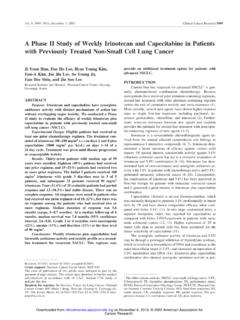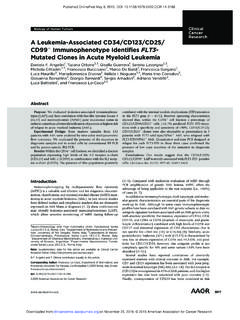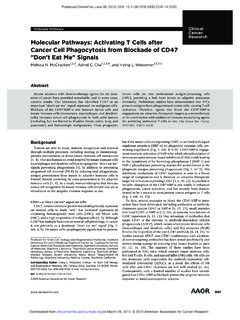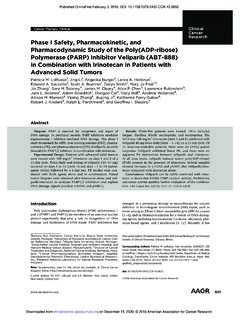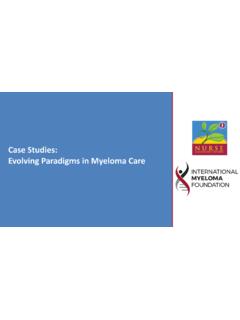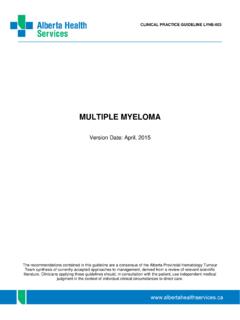Transcription of Panobinostat for the Treatment of Multiple Myeloma
1 Published OnlineFirst September 11, 2015; DOI: CCR Drug Updates Clinical Cancer Research Panobinostat for the Treatment of Multiple Myeloma s F. San-Miguel3, and Paul G. Richardson1. Jacob P. Laubach1, Philippe Moreau2, Jesu Abstract Panobinostat is a potent oral deacetylase inhibitor that alters plus bortezomib and dexamethasone signi cantly extended pro- gene expression through epigenetic mechanisms and inhibits pro- gression-free survival (median, months) compared with pla- tein degradation. It was recently approved by the FDA and EMA cebo plus bortezomib and dexamethasone (median, months.)
2 For use in combination with bortezomib and dexamethasone in P < ). Additional ongoing trials are evaluating Panobinostat patients with Multiple Myeloma who have received 2 prior regi- in combination with other partners in the relapsed/refractory and mens, including bortezomib and an immunomodulatory drug. newly diagnosed Treatment settings. This review focuses on pano- Panobinostat was approved based on results from the phase III binostat and its mechanism of action, pharmacokinetics, and PANORAMA 1 trial in patients with relapsed or relapsed and clinical data in the Treatment of relapsed or relapsed and refractory refractory Multiple Myeloma , which showed that Panobinostat Multiple Myeloma .
3 Clin Cancer Res; 21(21); 4767 73. 2015 AACR. Introduction FDA and EMA for use in combination with bortezomib and dexamethasone to treat patients with Multiple Myeloma who Multiple Myeloma is a hematologic malignancy that accounts have received 2 prior regimens , including bortezomib and an for approximately 1% of all neoplasms and 13% of hematologic IMiD. This review focuses on important clinical aspects of pano- malignancies (1). It is characterized by proliferation of clonal binostat, including its mechanism of action, pharmacokinetic plasma cells within the bone marrow and extramedullary sites pro le, and clinical data derived from studies of the agent in that in most instances secrete a monoclonal protein.
4 Typical relapsed or relapsed and refractory Multiple Myeloma . clinical characteristics include hypercalcemia, renal insuf ciency, anemia, and bone disease ("CRAB" features). Other manifesta- tions of the disease include increased risk of infection and periph- Mechanism of Action eral neuropathy (2). It has been estimated there were 24,050 new Panobinostat inhibits a broad range of DACs (Fig. 1), which are cases of Multiple Myeloma and 11,090 deaths due to Multiple also known as histone DACs (HDAC) because histones were the Myeloma in the United States in 2014 (1).
5 Rst known targets of DACs. It is now known that DACs regulate Survival of patients with Multiple Myeloma has signi cantly the acetylation of approximately 1,750 proteins involved in improved over the past decade with the introduction of the pro- diverse biologic processes, including DNA replication and repair, teasome inhibitors (PI) bortezomib and car lzomib and immu- chromatin remodeling, gene transcription, cell-cycle progression, nomodulatory drugs (IMiD) thalidomide, lenalidomide, and protein degradation, and cytoskeletal reorganization (5). Over- pomalidomide (3, 4).
6 However, these therapies are not curative, expression of DACs has been observed in Multiple Myeloma and and nearly all patients with Multiple Myeloma eventually relapse is associated with poor outcomes (6). and require further therapy. The prognosis among patients with Panobinostat is an inhibitor of all class I (HDACs 1, 2, 3, disease refractory to IMiDs and PIs is poor; among this group, only and 8), class II (HDACs 4, 5, 6, 7, 9, and 10), and class IV. approximately 22% respond to subsequent therapy, and among (HDAC 11) HDACs, with half maximal inhibitory concentra- those who do respond, the median event-free survival is <5 months tions in the nanomolar range for all class I, II, and IV HDACs.
7 And median overall survival (OS) is 9 months (3). Thus, there is The potency of Panobinostat was 10-fold greater for all HDACs a need for new treatments, particularly those with mechanisms compared with vorinostat, another pan-DAC inhibitor that of action that are distinct from those of IMiDs and PIs (4). was investigated for the Treatment of Multiple Myeloma , and Panobinostat belongs to a novel class of compounds called Panobinostat is among the most potent pan-DAC inhibitors deacetylase (DAC) inhibitors and was recently approved by the in clinical development (7, 8).
8 Panobinostat is thought to elicit antitumor activity primarily through epigenetic modulation of gene expression and inhibition 1. Dana-Farber Cancer Institute, Harvard Medical School, Boston, Mas- of protein metabolism. Inhibition of class I HDACs, which target sachusetts. 2 Nantes University Hospital, Nantes, France. 3Cl nica Uni- histones and transcription factors such as p53, may help reactivate versidad de Navarra, CIMA, IDISNA, Pamplona, Spain. epigenetically silenced tumor suppressor genes ( , p21; refs. 9, Corresponding Author: Paul G. Richardson, Dana-Farber Cancer Institute, 10) and modify gene expression via inhibition of signal trans- Harvard Medical School, 450 Brookline Avenue, Boston, MA 02215.
9 Phone: ducer and activator of transcription 3, Akt, and hypoxia-inducible 617-632-2104; Fax: 617-582-8608; E-mail: factor 1a (8). doi: Panobinostat has also been shown to act synergistically with 2015 American Association for Cancer Research. the PI bortezomib. This synergy can be explained in part via the 4767. Downloaded from on December 8, 2018. 2015 American Association for Cancer Research. Published OnlineFirst September 11, 2015; DOI: Laubach et al. Panobinostat Activation of tumor Histone Nonhistone Accumulation suppressor genes (epigenetic) of misfolded ( , p21, p27) proteins HDAC.
10 HDAC1, 2, 3 HDAC1, 2 HDAC6 Figure 1. Panobinostat inhibits a broad range of DACs that target histone and nonhistone proteins implicated in epigenetic dysregulation and protein Histones Tubulin degradation. Adapted with p53 HSP90 permission from Novartis Nucleus Pharmaceuticals Corporation (ref. 39). Aggresome Cytoplasm Cell death effects of Panobinostat on protein degradation. Multiple myelo- median maximum concentration was ng/mL, and the medi- ma cells have high levels of protein turnover and hence a sus- an area under the curve was 96 ng h/mL (13).
